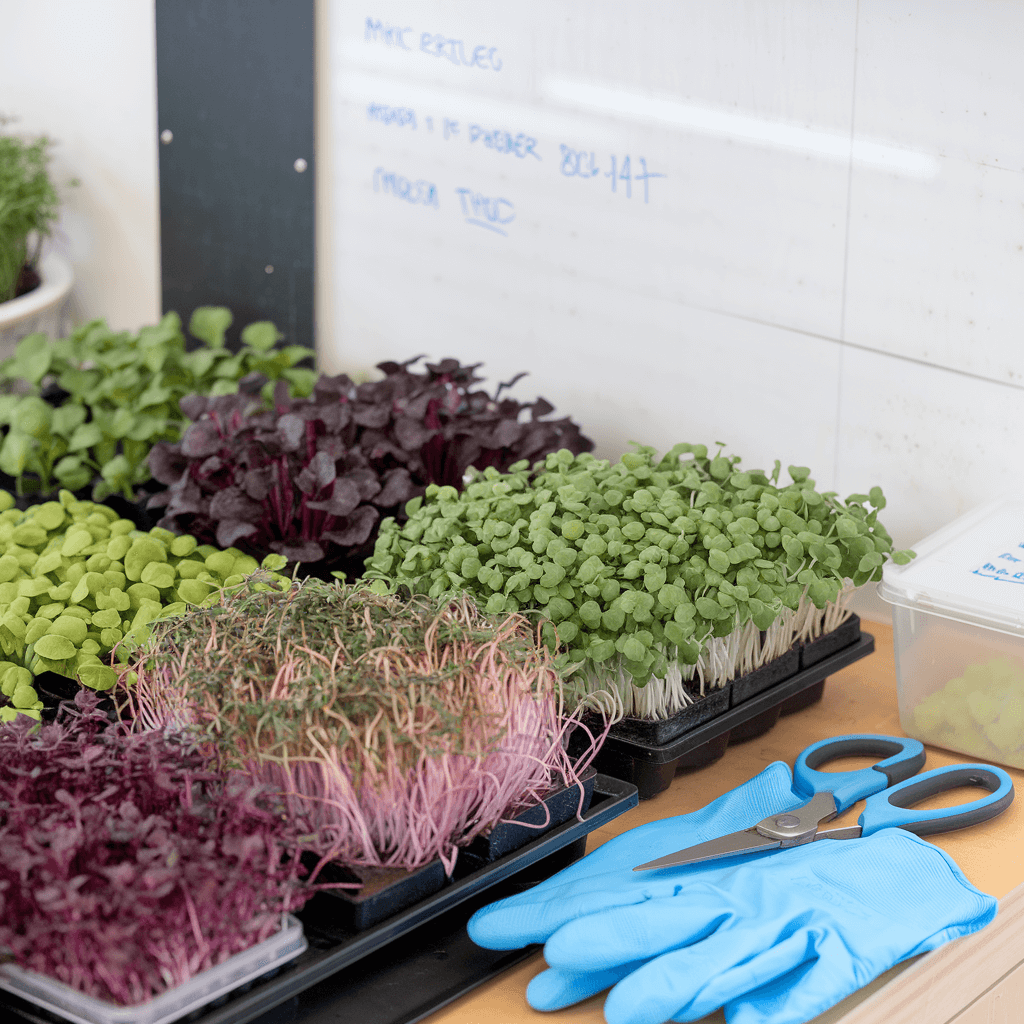The microgreens market is projected to reach $2.2 billion by 2028, growing at a compound annual growth rate of 11.3% (Source: Market Research Future, 2023).
For aspiring entrepreneurs, this represents a significant opportunity to enter a growing market with relatively low startup costs.
Table of Contents
- What Are Microgreens?
- Benefits of Selling Microgreens
- How to Start Your Microgreens Business
- Pricing and Profitability Guide
- Marketing Your Microgreens Business
- Ready To Start a Successful Microgreen Business?
- Growing and Operations Guide
- Legal Requirements and Compliance
- Frequently Asked Questions
- Conclusion and Next Steps
- Additional Resources
What Are Microgreens?
Microgreens are young vegetable greens harvested just after the first true leaves develop. Unlike sprouts, microgreens are grown in soil or hydroponic medium and typically take 7-21 days from seeding to harvest, depending on the variety.
Popular varieties include:
- Radish (fastest growing, 7-10 days)
- Pea shoots (high yield, 10-14 days)
- Sunflower (high profit margin, 12-15 days)
- Mixed salad greens (premium pricing, 14-21 days)
Benefits of Selling Microgreens
✓ Low Initial Investment ($500-2,000 startup) ✓ Quick Time to Market (First harvest within 2 weeks) ✓ High Profit Margins (200-400% possible) ✓ Year-Round Production Potential ✓ Multiple Revenue Streams
Calculate Your Startup Costs:
- Growing Space
- Basic Equipment
- Initial Supplies
- Marketing Budget
How to Start Your Microgreens Business
Required Equipment and Startup Costs
Essential Equipment List:
- Growing Racks ($200-500)
- Commercial wire shelving
- LED grow lights
- Timer systems
- Growing Supplies ($150-300)
- Growing trays
- Soil/growing medium
- Seeds
- Hand tools
- Packaging Materials ($100-200)
- Clamshell containers
- Labels
- Bags
- Scale
Equipment Cost Comparison
| Item | Basic Setup | Professional Setup |
|---|---|---|
| Growing Racks | $200 | $1,000 |
| Lighting | $150 | $600 |
| Supplies | $150 | $400 |
| Total Investment | $500 | $2,000 |
Pricing and Profitability Guide
Setting Your Microgreens Prices
Based on real market data from successful microgreens farmers, here are the current market rates (2025):
Market Channel Pricing Guide
| Market Channel | Price Range | Typical Order Size |
|---|---|---|
| Restaurants | $25-40/lb | 2-5 lbs weekly |
| Farmers Markets | $3-6/oz | 1-2 oz packages |
| Grocery Stores | $20-30/lb | 5-10 lbs weekly |
| Direct to Consumer | $4-8/oz | 4-8 oz monthly |
Profit Margin Analysis
Example Calculation for 1 Tray of Radish Microgreens:
Costs:
- Seeds: $2.50
- Growing Medium: $1.50
- Packaging: $2.00
- Labor (15 minutes): $5.00
- Utilities: $1.00 Total Cost: $12.00
Yield: 8-10 oz per tray Retail Price: $5/oz Gross Revenue: $40-50 Net Profit: $28-38 per tray
Marketing Your Microgreens Business
Finding Your Target Market
Primary Markets:
- High-End Restaurants
- Focus: Fine dining establishments
- Key selling points: Freshness, unique varieties
- Contact: Executive chefs directly
- Health-Conscious Consumers
- Focus: Fitness enthusiasts, health-focused families
- Key selling points: Nutritional benefits, organic certification
- Contact: Through social media, farmers markets
- Local Grocery Stores
- Focus: Independent and specialty stores
- Key selling points: Local production, consistent supply
- Contact: Produce managers
Success Story: Urban Microgreens LLC
- Started with $1,000 investment
- First year revenue: $45,000
- Key success factor: Focus on restaurant partnerships
- Current monthly revenue: $12,000
Marketing Strategies
Online Marketing:
- Instagram showcase of fresh harvests
- Facebook business page with weekly updates
- Email newsletter for regular customers
- Website with online ordering system
Weekly Marketing Tasks:
□ Post harvest photos
□ Send customer newsletter
□ Update availability list
□ Contact new potential clients
Ready To Start a Successful Microgreen Business?
Make YOUR First $2,000 In 30 Days Or Less Using The Corner Of Your Room…
Growing and Operations Guide
Production Planning and Scheduling
Weekly Production Schedule
| Day | Activity | Time Required | Notes |
|---|---|---|---|
| Monday | Seeding | 1-2 hours | Primary seeding day |
| Wednesday | Secondary seeding | 1 hour | Fill gaps in production |
| Friday | Main harvest | 2-3 hours | Restaurant deliveries |
| Daily | Maintenance | 30 minutes | Watering, monitoring |
Weekly Production Planner:
- Number of trays needed
- Seeding schedule
- Harvest projections
- Revenue forecasts
Quality Control Systems
Essential Monitoring Points:
- Temperature (65-75°F optimal)
- Humidity (50-65% ideal)
- Air circulation
- Light intensity
- Water quality
Checklist: Daily Quality Control
□ Check temperature readings
□ Monitor humidity levels
□ Inspect for mold/disease
□ Document growth progress
□ Clean work surfaces
Scaling Your Business
Growth Milestones:
- Starter Phase (0-3 months)
- 20-30 trays weekly
- 1-2 restaurant clients
- $1,000-2,000 monthly revenue
- Growth Phase (3-6 months)
- 50-75 trays weekly
- 4-5 restaurant clients
- $3,000-5,000 monthly revenue
- Expansion Phase (6-12 months)
- 100+ trays weekly
- Multiple market channels
- $8,000+ monthly revenue
Packaging and Presentation
Best Practices:
- Professional Packaging
- Clear clamshells for retail
- Bulk bags for restaurants
- Custom branded labels
- Storage Requirements
- Optimal temperature: 34-38°F
- Humidity: 95-100%
- Maximum shelf life: 7-10 days

Legal Requirements and Compliance
Licensing and Permits
Required Documentation:
- Business License
- State registration: $50-200
- Local permits: varies by location
- EIN (free from IRS)
- Food Safety Certifications
- FSMA compliance
- Good Agricultural Practices (GAP)
- Food handler’s certification
Compliance Checklist
□ Business registration
□ Food safety certification
□ Insurance coverage
□ Tax registration
□ Local health department approval
Insurance Requirements
Recommended Coverage:
- General Liability ($500-1,000/year)
- Product liability
- Property damage
- Personal injury
- Business Property ($300-600/year)
- Equipment coverage
- Inventory protection
- Business interruption
Frequently Asked Questions
How much money can you make selling microgreens?
Monthly revenue potential:
- Small operation (100 sq ft): $2,000-3,000
- Medium operation (300 sq ft): $5,000-8,000
- Large operation (1,000+ sq ft): $10,000-20,000+ *Based on 2023-2024 market data and verified grower reports
What are the most profitable microgreens to grow?
Top profit margins by variety:
- Sunflower shoots (300-400% margin)
- Pea shoots (250-350% margin)
- Radish microgreens (200-300% margin)
- Specialty mixes (400-500% margin)
Do I need a license to sell microgreens?
Requirements vary by location but typically include:
- Business license
- Food handler’s permit
- Agricultural permit (some regions)
- Sales tax permit
Regional Licensing Requirements
| Region | Required Permits | Estimated Cost |
|---|---|---|
| Urban | 3-4 permits | $200-500 |
| Suburban | 2-3 permits | $150-300 |
| Rural | 1-2 permits | $100-200 |
Conclusion and Next Steps
Getting Started Checklist
- Initial Planning
□ Market research in your area
□ Business plan development
□ Budget allocation
□ Location setup - Business Setup
□ Obtain necessary licenses
□ Purchase basic equipment
□ Set up growing area
□ Develop pricing strategy - Launch Preparation
□ Create marketing materials
□ Contact potential customers
□ Set up booking system
□ Prepare packaging
Additional Resources
Free Downloads
- Microgreens Business Calculator (Excel)
- Production Planning Template
- Customer Contact Tracker
- Quality Control Checklist
Recommended Tools and Software
- Square for payment processing
- Quickbooks for accounting
- Instagram Business for marketing
- Local Line for order management
Local Resources:
- Agricultural Extension Offices
- Small Business Development Centers
- Food Safety Regulators
- Farmers Market Associations
Further Learning
Educational Opportunities:
- Online Courses
- Commercial Microgreens Production
- Food Safety Certification
- Business Management
- Hands-on Training
- Local farm internships
- Agricultural workshops
- Industry conferences





